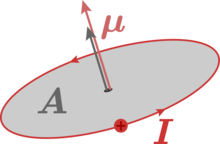Magnetic moment
In physics, the magnetic dipole moment (or magnetic moment) 
A magnetic dipole in an external magnetic field of flux density 
by which it is rotated in the field direction ( 

Important examples are the compass needle and the electric motor.
The unit of measurement of the magnetic moment in the International System of Units (SI) is A-m2. Often the product of 

Equality within a set or structure
- A magnetic moment can be the result of an electric current:
The current density distribution 
For a plane current loop this results in
where 

In electrical engineering, this is the basis for generators, motors and electromagnets, for example.
- Particles with intrinsic angular momentum (spin)
have magnetic momentum

Examples
Plane conductor loop
The following applies to a closed conductor loop
Thereby denotes
the current density at location
a volume integral
the current through the conductor loop
a path integral along the conductor loop.
Thus it follows for the magnetic dipole moment:
with the normal vector 


Current carrying long coil
The magnetic moment of a current-carrying coil is the product of the number of turns 


Where 

See also: magnetic chaining flux
Charged particle on a circular path
Classic
If the circular current is caused by a particle with mass 



The magnetic moment is thus fixed with the angular momentum
linked. The constant factor γ 

Quantum mechanical
The classical formula plays a major role in atomic and nuclear physics, because it is also valid in quantum mechanics, and a well-determined angular momentum belongs to each energy level of a single atom or nucleus. Since the angular momentum of spatial motion (orbital angular momentum, unlike spin) can only be integer multiples of the constant 
If the elementary charge 






Magnetic dipole moment of a surface with current flowing around it
The magnetic moment of particles and nuclei
Particles and atomic nuclei with a spin 






for proton (p) and neutron (n)


and correspondingly for other particles. The dipole moments of the atomic nuclei and their effects like the hyperfine structure are very weak and difficult to observe compared to the fine structure splitting based on electron dipole moments.
For the muon, instead of the mass of the electron, that of the muon is used in the magneton, and for the quarks, their respective constituent mass and third-integer electric charge.
If the magnetic moment is antiparallel to the spin, the g-factor is negative. However, this sign convention is not universally applied, so that often the g-factor of e.g. the electron is given as positive.
| Particle | Spin-g factor |
| Electron | |
| Muon μ | |
| Proton | |
| Neutron | |
The bracketed numbers indicate the estimated standard deviation.
According to Dirac theory, the Landé factor of fundamental fermions is exactly 

If the particles (e.g., electrons bound to an atomic nucleus) additionally exhibit orbital angular momentum, the magnetic moment is the sum of μ 


Magnetic field of a magnetic dipole
A magnetic dipole 

In it μ 

where 

Force and moment action between magnetic dipoles.
See also: Dipole force
Force effect between two dipoles
The force exerted by dipole 1 on dipole 2 is
It results
where 

Torque effect between two dipoles
The torque exerted by dipole 1 on dipole 2 is
where 
In the presence of multiple dipoles, the forces or moments can be superimposed. Since soft magnetic materials form a field-dependent dipole, these equations are not applicable.
Questions and Answers
Q: What is the magnetic moment of a magnet?
A: The magnetic moment of a magnet is a quantity that determines the force that the magnet can exert on electric currents and the torque that a magnetic field will exert on it.
Q: Which objects have magnetic moments?
A: A loop of electric current, a bar magnet, an electron, a molecule, and a planet all have magnetic moments.
Q: How can both the magnetic moment and magnetic field be considered?
A: Both the magnetic moment and magnetic field may be considered to be vectors having a magnitude and direction.
Q: Which direction does the magnetic moment point in a magnet?
A: The direction of the magnetic moment points from the south to north pole of a magnet.
Q: What is the relationship between the magnetic moment and magnetic field of a magnet?
A: The magnetic field produced by a magnet is proportional to its magnetic moment.
Q: What does the term magnetic moment normally refer to?
A: More precisely, the term magnetic moment normally refers to a system's magnetic dipole moment, which produces the first term in the multipole expansion of a general magnetic field.
Q: How does the dipole component of an object's magnetic field behave as distance from the object increases?
A: The dipole component of an object's magnetic field is symmetric about the direction of its magnetic dipole moment, and decreases as the inverse cube of the distance from the object.
Search within the encyclopedia


![{\displaystyle {\vec {m}}={\frac {1}{2}}\int \limits _{\mathbb {R} ^{3}}\mathrm {d} ^{3}r\left[{\vec {r}}\times {\vec {\jmath }}\,({\vec {r}})\right].}](https://www.alegsaonline.com/image/0614bfc79b358881e591100cb264bbcc704717c1.svg)


















![{\mathbf {F}}({\vec {r}},{\vec {m}}_{1},{\vec {m}}_{2})={\frac {3\mu _{0}}{4\pi r^{4}}}\left[{\vec {m}}_{2}({\vec {m}}_{1}\cdot {\vec {r}}_{n})+{\vec {m}}_{1}({\vec {m}}_{2}\cdot {\vec {r}}_{n})+{\vec {r}}_{n}({\vec {m}}_{1}\cdot {\vec {m}}_{2})-5{\vec {r}}_{n}({\vec {m}}_{1}\cdot {\vec {r}}_{n})({\vec {m}}_{2}\cdot {\vec {r}}_{n})\right],](https://www.alegsaonline.com/image/77d3dfece6939c3748b1264042797bffd7c2e36d.svg)
